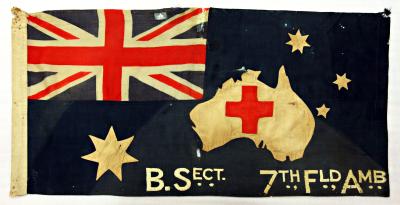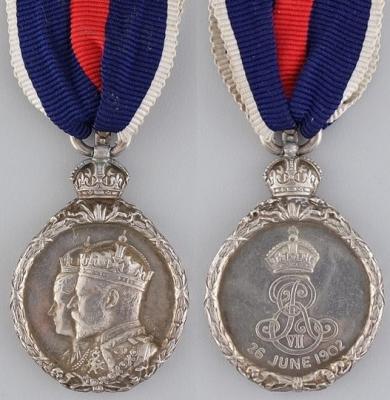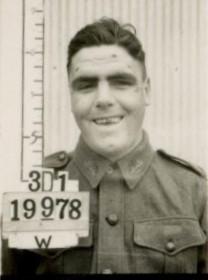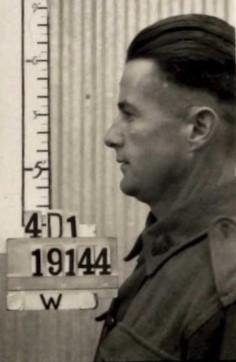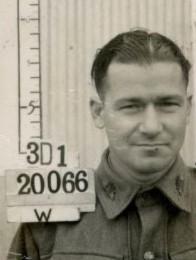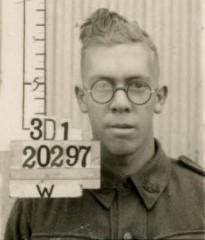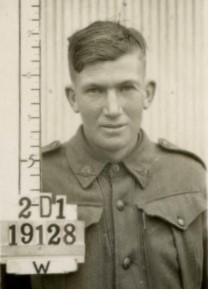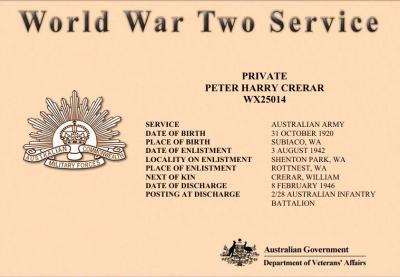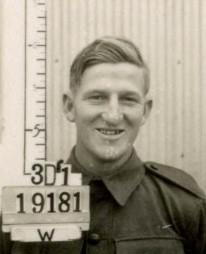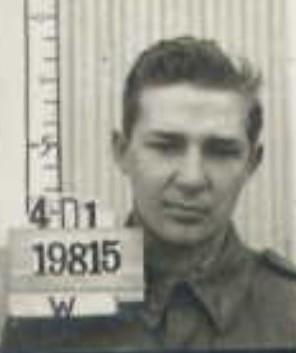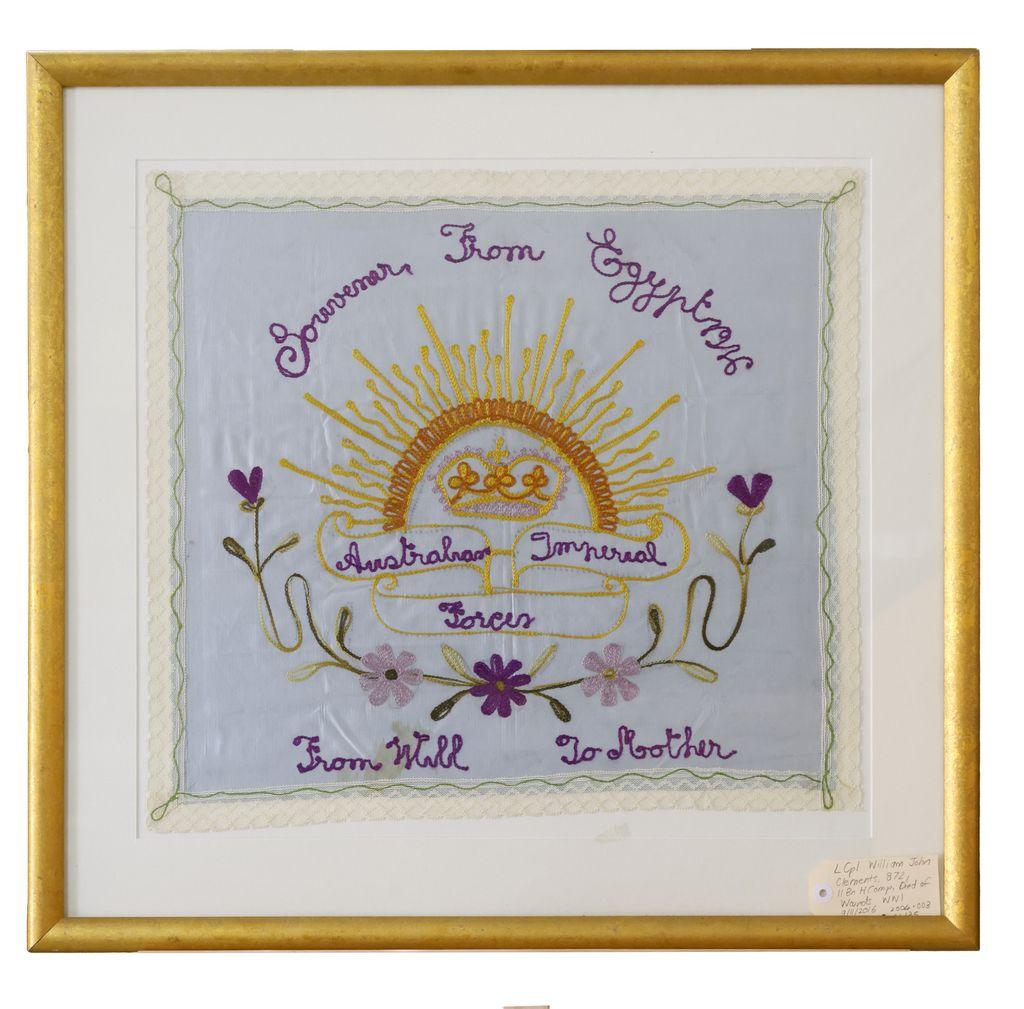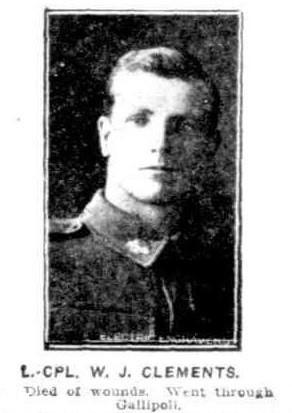World War 1, Framed Souvenir Embroidery, 872 CLEMENTS, 11 Battalion, 1916
Framed souvenir embroidery of Rising Sun plus embellishments personalised "From Will To Mother" sent home from Egypt to Wardering, East Narrogin, Western Australia to his mother, Emma, by 872 Lance Corporal William John Clements, 11 Battalion in 1918. Lance Corporal Clements died of wounds on 9 November 1916 and is buried in Bernafay Wood British Cemetery, Montauban, France.
The 11th Battalion was the first unit recruited in Western Australia for the Australian Imperial Force. Alongside the 9th, 10th, and 12th Battalions, it formed the 3rd Brigade. After only two weeks of initial training, the battalion departed Fremantle on 1 November 1914, arriving in Egypt for further training in early December. The 3rd Brigade led the ANZAC landing on 25 April 1915, being the first ashore around 4:30 am. Ten days post-landing, a company from the 11th Battalion conducted the AIF's first raid on Turkish positions at Gaba Tepe. Throughout the campaign, the battalion was heavily engaged in defending the ANZAC beachhead and participated in preparatory attacks for the battle of Lone Pine in August. They remained active at ANZAC until the evacuation in December.
Post-Gallipoli, the 11th Battalion returned to Egypt, where it was split to help form the 51st Battalion and replenished with reinforcements. In March 1916, the battalion sailed to France, joining the Western Front's trench warfare until 1918. Their first major battle in France was at Pozieres in July. Following this, they held trenches near Ypres and later returned to the Somme for winter.
In 1917, they participated in the advance following the German retreat to the Hindenburg Line. In April, during a German counterattack at Louverval, Lieutenant Charles Pope was killed performing actions that earned him a posthumous Victoria Cross. The battalion later fought in the Third Battle of Ypres.
In March and April 1918, the battalion helped stop the German spring offensive and joined the Allied offensive east of Amiens on 8 August, achieving a significant victory described by German General Erich Ludendorff as "the black day of the German Army." The 11th Battalion continued operations until late September 1918. The armistice on 11 November 1918 ended the fighting, followed by the Versailles peace treaty on 28 June 1919.
Details
Details
Donor Registration: 2004.003 On exhibit in the Temporary Exhibition Gallery, 1 August through 30 September 2025
Open in Google Maps
Nearest geotagged records:
Australian Army Museum of Western Australia
Australian Army Museum of Western Australia
Other items from Australian Army Museum of Western Australia
- 7 Field Ambulance Flag
- World War 1, Home Front, Commonwealth Button Fund (28) - Wattle Day "Peace, 1919"
- King Edward VII Coronation Medal
- World War 2, Western Australia, Rottnest Island AIF Enlistment, W56254 to WX30833 HOSKEN, 1942
- World War 2, Western Australia, Rottnest Island AIF Enlistment, W19978 TO WX25018 GANE, 1942
- World War 2, Western Australia, Rottnest Island AIF Enlistment, W18144 to WX25012 WILSON, 1942
- World War 2, Western Australia, Rottnest Island AIF Enlistment, W20066 to WX25002 ISBEL, 1942
- World War 2, Western Australia, Rottnest Island AIF Enlistment, W20297 to WX25003, RUSS, 1942
- World War 2, Western Australia, Rottnest Island AIF Enlistment, W19128 to WX25011 COCKMAN, 1942
- World War 2, Western Australia, Rottnest Island AIF Enlistment, W19818 to WX25014 CRERAR, 1942
- World War 2, Western Australia, Rottnest Island AIF Enlistment, W19181 to WX25013 FOWLES, 1942
- World War 2, Western Australia, Rottnest Island AIF Enlistment, W19815 to WX 25015 JEFFERY, 1942
